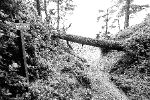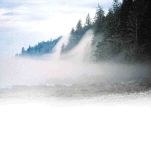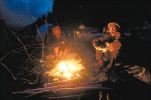Five days on the
Juan de Fuca trail
Hiking the southwest coast of Vancouver Island is an
adventure in fog, rain, sunshine and whales
Grady
Semmens
Calgary Herald
Saturday, October
19, 2002

|
| It's
even easier to appreciate towering cedar trees when they provide
natural bridges over rugged terrain and steep hillsides.
|
| |

|
| CREDIT: Photos,
Grady Semmens, Calgary Herald |
| |
| Moody
mornings are the norm on the west coast of Vancouver Island. Fog,
rain and dense cloud can be gloomy but often lift as the day progresses. |
| |

|
| An
expansive reef shelf provides scenic and mercifully flat walking
near the end of the Juan de Fuca Trail. |
| |

|
| Thick
tendrils of fog wrap the forest above Bear Beach. |
| |

|
| The
author, right, and his hiking companion, Doug McKinlay, chill
out in front of a bonfire on Chin beach after a long day of hiking. |
| |
| CREDIT:Photos,
Grady Semmens, Calgary Herald |
|
Heads hanging in the rain,
backs curled under the weight of a fully loaded pack, it happens at
the best of all possible moments.
We pick our way across a
beach full of slippery, wet boulders that threaten to snag and break
your ankle at the slightest misstep.
I'm chilled to the bone in
my soaked clothes, mind wandering aimlessly when I first hear the sound.
It begins with a low hissing, a kind of dull roar.
"What's that? Some kind of
plane?" I call ahead to Doug.
We both stop dead, trying
to pinpoint the puzzling noise.
Turning my head, I strain
my eyes into the grey expanse of ocean.
About 200 metres out, where
the water meets the sky in a seamless expanse of grey, a black and white
figure leaps into focus. A killer whale rockets out of the water, crashing
backwards with an enormous slapping sound that takes a second or two
to reach our ears. Moments later, another jumps and then we see several
sleek dorsal fins bobbing above the surface. The sound of the whales
exhaling through their blowholes fills the air as the pod of orcas frolic
out in the white froth churned up by their fins.
The gloom that surrounded
our day is quickly replaced by a mellow sort of joy as we sit back to
watch the antics, amazed at another splendid moment in a trip that has
been chock full of them while trekking along the Juan de Fuca Trail.
But that was just the end.
To get a real sense of the experience you need to start at the beginning
-- four days and more than 40 kilometres before.
Forty-seven kilometres of
towering forest interspersed with rocky coastline and stretches of sandy
beach, the Juan de Fuca Trail meanders along the southwest coast of
Vancouver Island from China Beach to
the fishing village of Port Renfrew, at the end of Highway 14. Potentially
a southern extension of the longer, more rugged and more famous West
Coast Trail, the Juan de Fuca is a challenging undertaking in its own
right, with sections of remote and strenuous walking that will punish
even the most seasoned of hikers.
Without the need to make
reservations, it takes far less advance planning and is still blissfully
free of crowds, especially if you choose to hike it in the fall or spring
instead of the height of summer.
While many sections can be
accessed for day hiking, and some gonzo trekkers and distance runners
have been known to do the entire thing in two days or even one gruelling
day, the best way to experience the place is to set aside four or five
days to hike the entire length. That way each day contains a decent
hike but also allows you enough time to stop and soak up the scenery
and delve into potential side adventures along the way.
Day One
After posing for the obligatory
"before" photograph of ourselves at the trailhead in our clean clothes
and clean-shaven faces, we started out from the China Beach parking
lot, the point from which brown wooden posts begin counting your progress
along each kilometre of the well-travelled route.
The first two kilometres
are a good snapshot of things to come.
Winding through a mossy forest,
across a sturdy metal suspension bridge and then gradually down to Mystic
Beach, which is the perfect place to stop for a short breather and to
discard the mental baggage of the civilized world left behind.
The sun burned off the morning's
fog and began beating down on the slate-coloured sand and illuminating
the showers of fresh spring water pouring off the rocky ledges at the
south end of the beach.
From there, it was another
six kilometres of twisting and relatively flat forest walking which
includes numerous bridges and staircases carved out of ancient trees
decaying on the forest floor and viewpoints overlooking the Straight
of Juan de Fuca and the blue peaks of Washington state's Olympic Peninsula
in the distance.
At Bear Beach, we found a
perfect campsite where the sand meets the trees beside a trickling creek
where we washed up before spending the rest of the evening smoking cigars
and sipping Wild Turkey in front of a roaring driftwood fire.
Day Two
Woke to a heavy fog and light
drizzle that cast a soggy pall on the day ahead. On subsequent trips,
I've come to realize this is typical weather on this patch of coastline
where the weather often goes through many incarnations during the day.
Gore-Tex is your greatest ally against damp weather that can blow in
quickly from out of the blue.
A quick breakfast of porridge
and we were on the trail for the 11-kilometre leg and lung-buster of
a hike to Chin Beach (not to be confused with China Beach, our starting
point).
This is the most strenuous
section of the hike as the trail relentlessly climbs hundreds of metres
up into the forest and then dives back down to sea-level a dozen times
as you beg for a straight, flat section that never comes.
There are plenty of delights
along the way to distract you from the slog, however. Meandering through
lush second-growth forest that almost seems too tropical to be found
in Canada, the trail passes countless old-growth cedars left behind
by loggers when the area fell to the axe at the turn of the century.
The numerous hollowed-out
tree trunks are impossible to pass without standing in and pretending
you are one of Tolkien's hobbits standing in the doorway of his home.
Six hours later, we arrived
at the small plywood and Plexiglass emergency cabin nestled in the trees
above Chin Beach, and stopped to sign the log book on the table inside.
The bunks looked inviting
but since the sun was out we opted to descend to the beach where we
set up camp behind a wind shelter made by previous campers out of planks
of driftwood. There we hung our sweat-saturated clothes out to dry.
The dull aching of my legs
was the only thing reminding me of my earth-bound existence as a I watched
shooting stars arc across the heavens as the red coals of the camp fire
smouldered into oblivion.
Day Three
Rising late in the morning,
it was good to find I wasn't the only lazy one. I spotted a fat harbour
seal sunning himself on a rock ledge just out from our campsite. He
watched, half-interested, as we broke camp.
We reached the north end
of the beach after passing towering cedars wrapped in dense tendrils
of leftover fog then clambered up a small rock ledge leading into the
trees, beginning a very diverse walk.
It begins with up-and-down
sections through the forest, quickly bringing you to the suspension
bridge that sways over the yawning canyon of Loss Creek.
Those with even slight vertigo
will want to keep their eyes firmly fixed ahead since the bridge deck
is simply a metal grate that allows you to peer past your feet to the
creek bed hundreds of metres below.
The trail then meets an old
logging road that runs flat and straight through stands of dense deciduous
trees before dropping back into more hilly sections with plenty of muddy
patches.
The last two kilometres cling
precariously to cliffs that hug the shore, leading to a perfect waterfall
spilling out of the forest into the ocean just before reaching Sombrio
Beach at Kilometre 27, where beach camping is delightful on sandy
stretches that allow you to sit gazing at the sea from the door of your
tent.
Day Four
The skies were partially
cloudy but the morning was still blissful. A humpback whale chose the
little cover in front of our campsite in which to leisurely circle around
for an hour, sending plumes of spray into the air from his blowhole
after dipping under the surface every few minutes.
Following him north along
the length of the beach, we passed a multitude of tents as we got closer
to the parking lot at the end of a short gravel road that connects Sombrio
Beach to the highway.
Leaving behind the car campers
and surfers, we chose this day to cover the most ground on a section
of trail that turned out to be very different, ecologically.
After the beach, the trail
stayed relatively mellow, passing through several newly-replanted cut
blocks bursting with riotous colours of wildflowers and berries.
At kilometre-37 we reached
the deserted parking lot at Parkinson
Creek, where we polished off most of our remaining food, including
the last nub of garlic sausage that had turned an unpalatable green.
Stashing our packs in the
brush, we trotted down a small side trail to a small wooden observation
platform that juts precariously over the water, overlooking a rocky
grotto known to be a popular gathering point for herds of sea lions.
Alas, there were no signs of life.
The last stage started with
excitement as we entered a berry-rich cut block. Moments after filling
our water bottles at a creek, we turned around in time to see a black
bear lope across the road, just metres away, eyeing us nervously as
he turned his rump and crashed away into the bush.
A few minutes later, we hit
the shore for a delightful walk along a wide and flat reef shelf that
stretches for two kilometres, allowing you to scan the sea as you walk,
picking your way around tide pools teeming with sea creatures.
At Kilometre 40 we pulled
into the forested backcountry campground at Payzant Creek, where we
finished the last of the whisky and cigars before turning in.
Day Five
Waking up in a pool of water,
rain steadily dripping through the roof of the tent, all we could do
was pack our soggy belongings and leave. But what began as a dismal
and disheartening end to the trip turned out to be one of the most uplifting
sections of the trail as we sat enraptured by the offshore orca action.
Warmed by the amazing display, it was the pangs of hunger that finally
motivated us to shoulder our packs and continue the final leg of the
trek.
The last few kilometres flew
by as we stopped only to spend a few moments under a rocky outcropping
to change into our cleanest and driest clothing for our return from
the wilderness.
At Botanical
Beach, a popular beachcombing spot, the trail turns into a wide
gravel road that leads through the trees to the parking lot, where we
snapped our "after" shot at the 47-kilometre post, doffed our packs
and boarded a shuttle bus that whisked us back to China Beach in under
an hour.
As with any outdoor adventure,
the end comes with sadness for leaving behind a simpler way of life.
It's tempered, however, by the relief of returning to the comforts of
civilization.
"You gotta have the halibut
and chips with a cold mug of beer. It's the best meal you'll ever have
in your life," says the outgoing waiter at The Breakers, a cosy roadside
diner in Jordan River, just west of Sooke. After four days living on
little more than pasta, porridge and Power Bars, he is absolutely right.
If You Go:
- The Juan de Fuca Trail
begins at China Beach Provincial Park. From Victoria, drive west on
Highway. 14 towards Sooke. The signed turnoff for the trailhead is another
half an hour past Sooke. Shuttle bus services, such as Trailbus (
or ) can be arranged to provide transportation from Victoria
and between trailheads.
- Vancouver Island writer
Donald C. Mills' 1999 book Giant Cedars, White Sands is the definitive
guidebook for the trail. The 96-page book provides detailed descriptions
of the entire trail, complete with a fold-out topographic map and descriptions
of side trails along the way. It can be purchased over the Internet
at www.genio.net/pallas or at many outdoors stores and bookshops in
the Greater Victoria area.
- Camping along the trail
costs
$6 per night, per tent, payable
at kiosks at the China Beach, Sombrio
Beach, Parkinson Creek and Botanical
Beach parking lots.
- Bears and cougars are abundant
along the trail, making backcountry camping etiquette mandatory and
carrying bear bells and pepper spray advisable. Creek water is generally
drinkable,but boiling or using a water filter is recommended.

